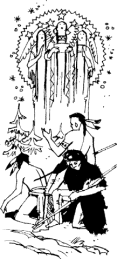Saint Jean de Brebeuf (1593-1649), a Jesuit missionary to the Hurons, wrote this carol in their language as both gift and to help in his missionary and teaching efforts. In 1649 Jean de Brebeuf and many Huron Indians were killed by a rivaling Iroquese tribe. The song was rejuvinated in Quebec, where many of the surviving Huron settled. It has become a national treasure in both English and French versions and has been commemorated also in a set of Canadian stamps.
'Twas in the moon of winter time,
when all the birds had fled,
that mighty Gitchi-Manitou
sent angel choirs instead;
before their light the stars grew dim,
and wondering hunters heard the hymn:
Jesus your King is born, Jesus is born,
in excelcis gloria.
Within a lodge of broken bark
the tender babe was found,
a ragged robe of rabbit skin
enwrapped his beauty round;
but as the hunter braves drew nigh,
the angel song rang loud and high:
Jesus your King is born, Jesus is born,
in excelcis gloria.
O children of the forest free,
O sons of Manitou,
the holy child of earth and heaven
is born today for you.
Come, kneel before the radiant boy,
who brings you beauty, peace and joy:
Jesus your King is born, Jesus is born,
in excelcis gloria.
Prince Edward Island Christmas Screensaver
Christmas Traditions in France and Canada
| Der Jesuitenpriester Jean de Brebeuf (1593-1649) schrieb das Huron Weihnachtslied während er bei den Huron Indianern als Missionar beschäftigt war. Dieses Lied war ein Geschenk an die Hurons und eine Lehrmethode, die Geburt Jesus Christus und die Religion des weissen Mannes darzustellen . Im Jahre 1649 wurde Jean de Brebeuf und eine grosse Anzahl von Huron Indianern von rivalisierenden Iroquese Indianern getötet. Das Huron Weihnachtslied wurde in Quebec in französischer Sprache wiedergeboren, wo sich die überlebenden Huron Indianer ansiedelten. Es ist bis heute ein historischer Nationalschatz, dem auch eine kanadische Briefmarkenserie gewidmet ist.
 Listen-hört Listen-hört

Erster Vers in der Huron Sprache:
Estennialon de tsonwe Jesous ahatonhia
Onnawatewa d' oki n' onwandaskwaentak
Ennonchien skwatrihotat n' onwandilonrachatha
Jesous ahatonhia, Jesous ahatonhia.
Prince Edward Island Weihnachten Bildschirmschoner zum hochladen
Weihnachtstraditionen in Frankreich und Kanada
|